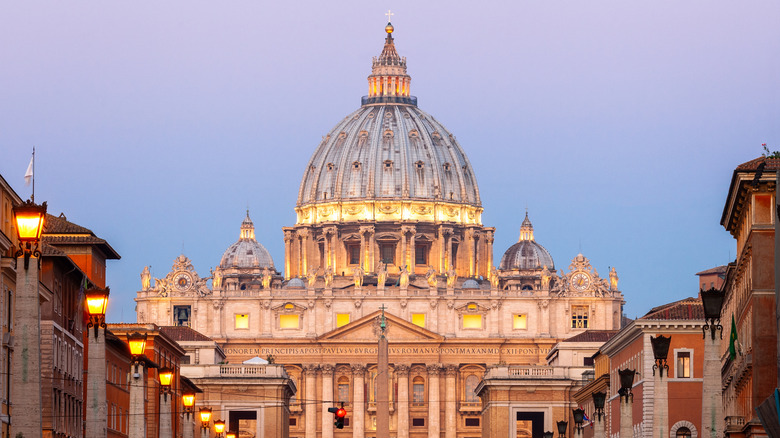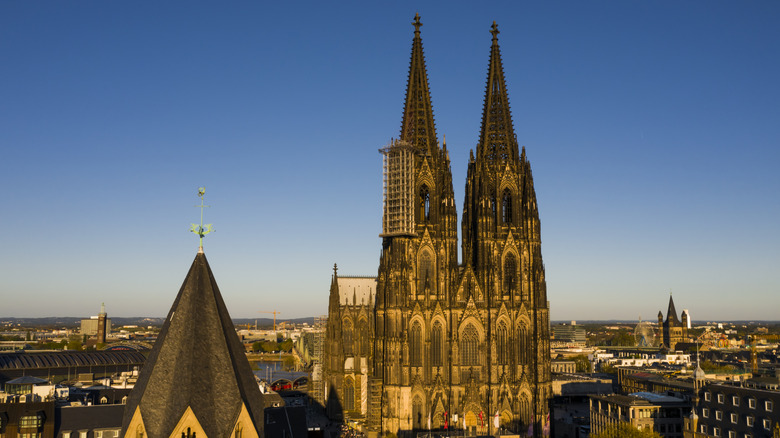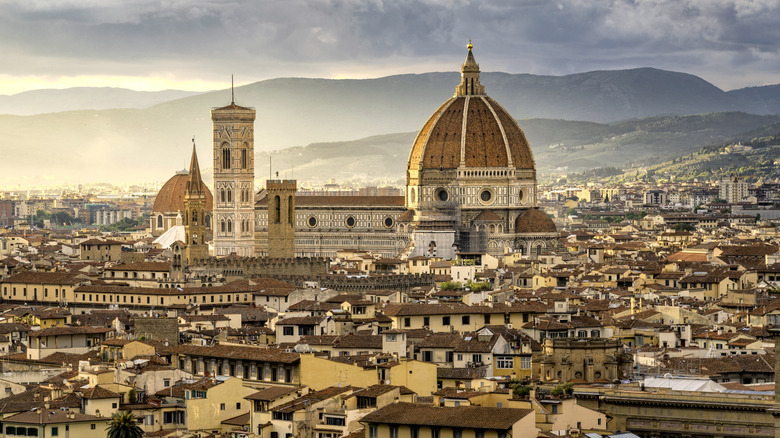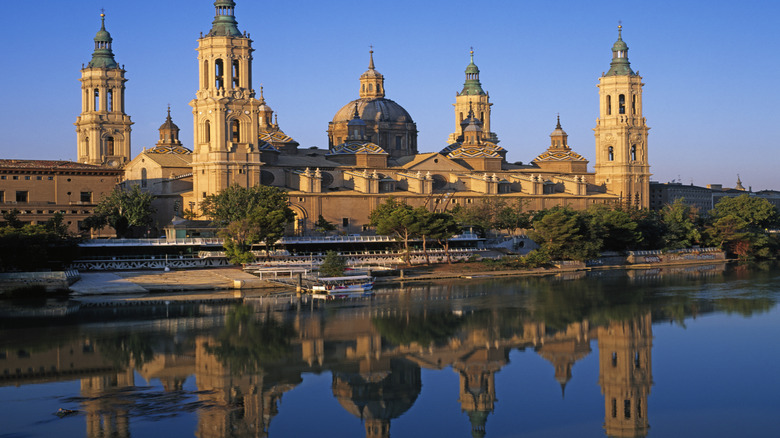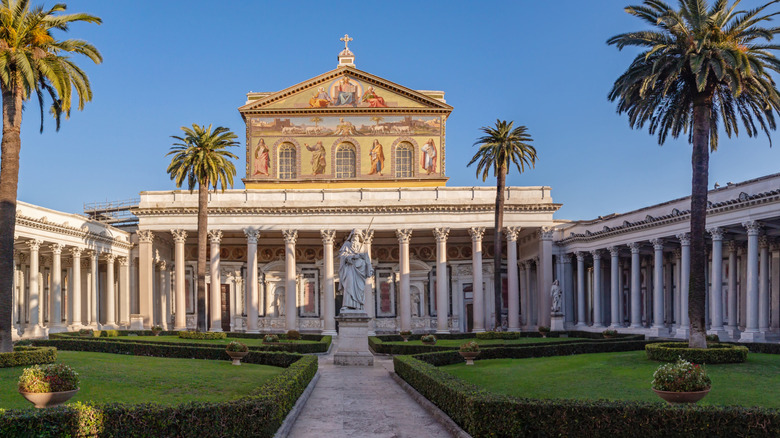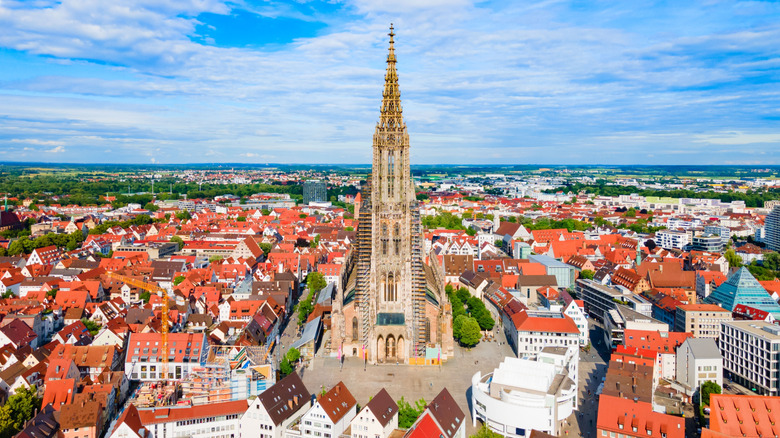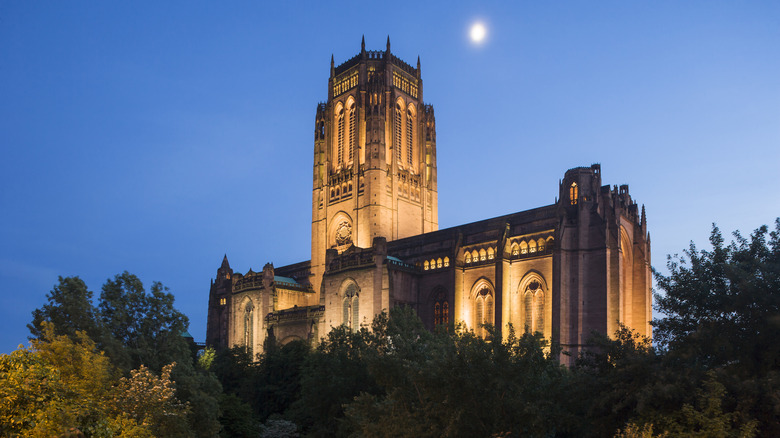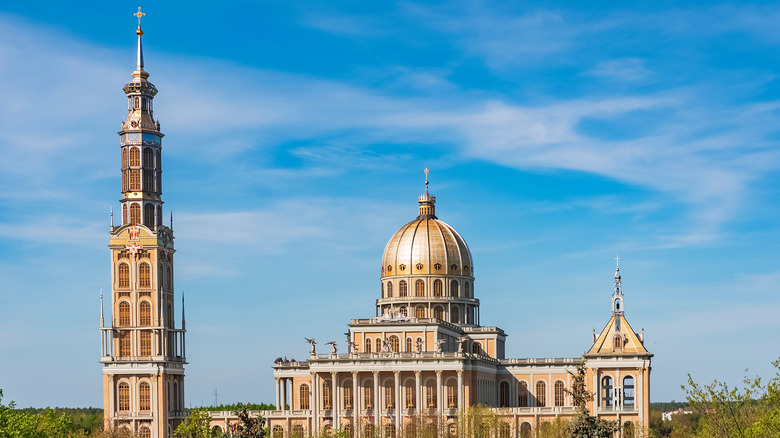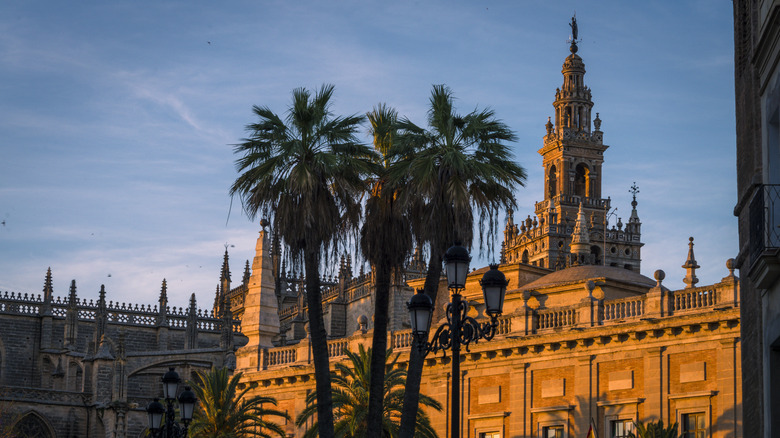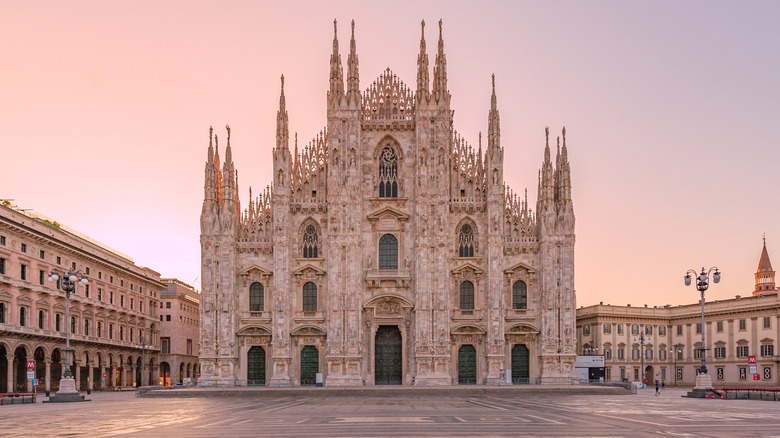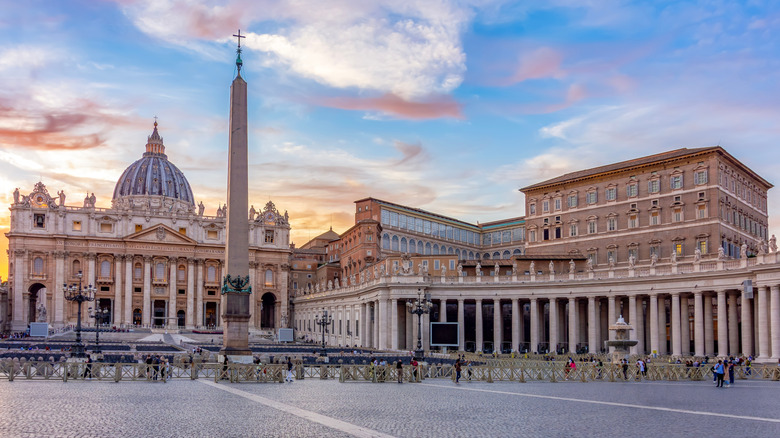The Largest Cathedrals In Europe You Have To See To Believe
A cathedral isn't just a grand church. In modern English, the word has come to signify a towering monument, the pouring of one's heart and soul, and commitment to a magnificent cause. For that reason, "building a cathedral" is a metaphor for a gargantuan task that requires your entire being and then some but never seems to reach completion. All over Europe, kings, popes, and pilgrims spent centuries of blood, sweat, tears, and money building the most exquisite tributes they knew how to the divine.
This has resulted in buildings that showcase the best of centuries of collective genius: temples of epic, staggering size, detail, beauty, and awe. We found some of the largest cathedrals in Europe based on interior floor size space, the most traditional measurement of cathedral size. From stained glass to marble to heartbreaking statues to famous tombs to gleaming gold domes, here are cathedrals you need to see to believe, ordered from smallest to largest.
Cologne Cathedral, Germany
Anything that takes 632 years to complete and survives 14 bomb hits is bound to contain a special kind of magic. Cologne Cathedral is a Gothic masterpiece known for its soaring twin spires. It serves as an eternal testament to perseverance, craftsmanship, and perhaps a bit of divine luck. Construction began in 1248 on a cathedral meant to house the presumed relics of the Three Wise Men, who visited Jesus in the manger. The work halted in 1530, when the project ran out of funds, and the cathedral remained unfinished until 1842.
The Prussian government and the city of Cologne restarted construction using rediscovered medieval plans, and "God's Eternal Building Site" was finally finished in 1880. At the time, the 516-foot cathedral was the tallest building in the world. In 2025, Cologne Cathedral is the tallest twin-spired church in the world, boasts a large church façade, and is the third tallest church in Europe. You'll feel the divine presence and centuries of history as you marvel at the soaring ceilings held by piers decorated with crystalline stained glass and elaborate statues and carvings.
This impossibly intricate cathedral hosts a number of divine relics and tombs, including the Shrine of the Three Kings, a gold reliquary said to hold the bones of the Magi, and the tombs of medieval archbishops. The cathedral also hosts a large swinging bell and what's believed to be the largest altar in Europe. If you'd like to climb the tallest church spire in the world, bring comfortable shoes because it's 533 steps before you're rewarded with views just as divine as the cathedral interior.
Florence Cathedral, Italy
The magnificent red dome and intricately carved campaniles of the Florence Cathedral add up to so much more than the sum of their parts. This majestic cathedral is a potent symbol of Florence, the Renaissance, Italy, and Western civilization, on par with Michelangelo's "David" or the Sistine Chapel. Construction on this masterpiece began in 1296 and finished in 1436, a relatively short time for medieval cathedral construction. Still, one of the most iconic parts of the structure was left incomplete. The intricate geometric designs and fanciful statues on the Neo-Gothic façade were not finished until 1887. There's a reason the expression "to build a cathedral" means to complete a difficult task. But the hard work paid off.
Once you properly skip the lines to Florence Cathedral, you'll enter a vast temple with ceilings that soar 375 feet. A series of dreamy frescoes cover a whopping 38,750 square feet of dome ceiling and depict "The Last Judgement" over 6 concentric circles. The cathedral also contains stunning stained glass windows, the famed counterclockwise clock from 1443 that marks sunset at the start of the day, and several more imposing frescoes and portraits.
For panoramic city views (check out the church showcasing stunning views of Florence), you can climb to the top of the dome or the apex of Giotto's Campanile bell tower. Along the 414 steps, you'll enjoy intricate sculptures of planets and prophets. When you get to the top, you'll be rewarded with views of another work of art: the city of Florence. For more stunning sights, hit these must-visit spots in Florence.
Basilica of Our Lady of the Pillar, Spain
In A.D. 40, the Virgin Mary is believed to have appeared to St. James the Greater on the banks of the Ebro River in Spain, where she told him to build a church in her honor, the first in history. He tried his best, but it was quite a process. A chapel was built a few years later but was destroyed. Subsequent churches in her honor were constructed in the 12th and 15th centuries but also met the same fate, with just a few remnants remaining today.
In the 17th century, construction on the current basilica began, and this time, Mary made sure her church was here to stay. Three bombs were dropped on the cathedral during the Spanish Civil War in 1936, but none exploded, a miracle widely attributed to Mary and divine intervention. Today, two of those bombs are displayed inside the cathedral as divine relics. It was quite a miracle because the loss would have been devastating.
The cathedral is a sprawling complex of 11 domes and 4 bell towers, a regal and imposing feature of the Zaragoza skyline. It's built with Baroque, Romanesque, and Gothic influences, a mélange of architectural styles that reflect the rich history of the cathedral and the society around it. Inside, a statue of the Virgin Mary stands atop a jasper column, or "pillar," that she gave to St. James, and pilgrims the world over come to kiss it. Architectural and artistic pilgrims will marvel at the cathedral domes decorated with frescoes from Francisco Goya, as well as choir stalls and organs that date back to the Renaissance.
Basilica of St. Paul Outside the Walls, Italy
You can't tour Europe's greatest cathedrals without stopping in Rome, the center of Catholicism and home to the world's oldest, grandest cathedrals. The Eternal City houses the Four Major Basilicas, which are granted special status and once fell under the direct jurisdiction of the pope. Pilgrims to Rome are expected to visit each of the four churches, which all represent a distinct pillar of early Christianity.
The most famous, St. Peter's Basilica, is supposedly built over the tomb of the Apostle Peter, the world's first pope. St. John Lateran is the highest-ranking church and the official cathedral of the pope. St. Mary Major is the oldest church dedicated to the Virgin Mary. St. Paul Outside the Walls, known for its columns and shimmering gold façade, is built on the burial site of St. Paul the Apostle, who was instrumental in spreading Christianity across the Roman Empire. In A.D. 324, a small basilica was built over his tomb. Subsequent Roman emperors and popes continued expanding the basilica over the centuries, and by the 19th century, it was the second-largest church in Rome.
Today, St. Paul's is supported by 150 marble columns, giving it the grand and open feeling of an ancient Roman courtyard. On the front façade, a Byzantine-style mosaic made of little pieces of glass with gold leaves dazzlingly depicts Christ and his apostles. To see one of them, go to the main altar, where the Tomb of St. Paul lies. Surrounding Paul are the 80 granite columns of the Five-Nave Interior, which are crowned by gold mosaic portraits of all 265 popes. Check out more things to do if you only have a day to spend in Rome.
Ulm Minster, Germany
Who said science and religion can't coexist? Ulm, a sleepy university town in southern Germany, has two major claims to fame. It is the birthplace of Albert Einstein and the home of Ulm Minster, widely celebrated as the cathedral with the tallest church tower in the world. Just about anywhere you go in Ulm, you'll see the soaring 530-foot Gothic spires crafted with Einstein-level artistry and precision.
Construction on this medieval skyscraper began in 1377 when the people banded together to raise funds to build a safer church than the one that had just burned down. It became a Lutheran church during the Protestant Reformation. During this time, construction stopped due to financial and political upheaval. It wasn't complete until 1890, after Einstein had already been born. The six centuries of construction had paid off: The Ulm Minster remains one of the world's largest and grandest churches. If you'd like to climb to the top of the world's tallest church tower, book some sessions with your trainer first: it's 768 steps.
The exterior of the Ulm Minster is a dazzlingly intricate masterclass in Gothic architecture, boasting interwoven layers of spires, flying buttresses, sculptures, statues, and carvings rich in religious symbolism. The interior is comparatively sparse, though still full of awe and grandeur. Guests will marvel at choir stalls from the 15th century, a stained glass window honoring Einstein, and an organ once played by another German-speaking genius: Wolfgang Amadeus Mozart.
Liverpool Cathedral, United Kingdom
If you ask the average person what comes to mind when you mention Liverpool in the 1970s, they're more likely to think of the Beatles than an Anglican cathedral. (Here's a Beatles-inspired guide to London and Liverpool.) But the world's fifth largest cathedral, which was consecrated in 1978 by Queen Elizabeth II, is just as much of a quirky, record-breaking powerhouse as the Fab Four.
First, the Liverpool Cathedral is the longest cathedral in the world. Because it was built on a rocky cliff, it needed to be oriented from north to south rather than east to west, as is traditional. It's also the largest religious building in Britain and boasts the world's tallest Gothic arches. The cathedral also does its hometown proud by claiming a number of musical superlatives. It contains the world's largest operational organ by some measures, with 10,268 pipes and 200 stops. It is also the heaviest and highest ringing peal of bells, which weighs 16.8 tons and hangs 220 feet in the air.
Beyond music, the Liverpool Cathedral is more in touch with the spirit of the Beatles than one might expect. Just above the doors over the main entrance, contemporary artist Tracey Emin created a neon art installation that reads in handwritten cursive, "I felt you and I knew you loved me," which one can almost hear John Lennon singing. The cathedral contains another unexpected, thoroughly British gem. It was conceived by Giles Gilbert Scott, the same architect who designed Britain's iconic red phone box in 1924. To honor his memory, a red phone box is found inside the cathedral.
Basilica of Our Lady of Licheń, Poland
The Virgin Mary is willing to do a lot of favors, but she likes a shrine in her favor as a thank you. In 1813, almost 1,800 years after she revealed herself to St. James the Greater, she appeared to Tomasz Kłossowski, a Polish soldier dying on a battlefield during the Napoleonic Wars. She told him that he would survive and asked him to find a specific image of her and put it in a public place to give people strength in hard times.
Years later, during a pilgrimage, he found a small painting of Mary on a piece of wood and hung it in the Grablin Forest. Pilgrims flocked to the forest to pray to her during the 1852 cholera epidemic, and a chapel was built. During Poland's difficult 20th century, this small chapel could no longer handle the crowds of pilgrims who came to Mary seeking solace. In 1994, the Marian Fathers, who were custodians of the chapel, decided to build a monumental cathedral, which would be funded completely by pilgrims. Barbara Bielecka, one of the few women to design a cathedral, worked on the basilica that opened 10 years later.
Today, Our Lady of Licheń is a 464-foot monument to Polish Catholicism built in a Neo-Baroque, postmodern style. Outside the largest church in Poland is a beautiful assemblage of regal columns that lead up to a glittering golden dome. Inside, the grand shrine includes a main altar with the original red and gold painting of Mary above the tabernacle. Mary is surrounded by a massive organ, as well as frescoes and mosaics devoted to her and Polish history.
Seville Cathedral, Spain
Few know that Christopher Columbus is buried inside a former mosque, close to a dangling crocodile sculpture. We now head to one of Europe's most sumptuous, mysterious, and delightfully quirky cathedrals. The towering Seville Cathedral in southern Spain is a UNESCO World Heritage Site and the largest Gothic cathedral in the world.
The cathedral was originally a mosque built in 1172 when Muslim Moors ruled Spain. Several Islamic design elements remain, from the tall Giralda tower, once a minaret, to the design of the orange tree courtyard to the Moorish arches decorated with Arabic-style patterning. The floor plan is also oriented from east to west, which is typical for mosques but not Gothic cathedrals. In 1248, King Ferdinand III of Castile captured Seville, and the Almohad mosque was consecrated as a church. An earthquake in 1356 severely damaged the structure of the building, and over the next century and a half, a magnificent Gothic cathedral was built over the remains. Today, it is a grand and fascinating mélange of Gothic, Moorish, Renaissance, and Baroque architecture, where every step reverberates with world history.
Perhaps nowhere does history reverberate more strongly than in the tomb of Columbus. The famous explorer's body was in Havana but was transferred back to Spain in 1898 after Spain lost Cuba to the United States. Columbus was buried in a grand tomb held up by four statues representing Spain's medieval kingdoms. By 2024, DNA testing had confirmed that at least part of the remains belonged to Columbus. Today, he rests amid other royal tombs, magnificent stained glass windows, and the gleaming gold Retablo Mayor, the world's largest altarpiece that features over 1,000 biblical figures.
Milan Cathedral, Italy
The Milanese often say that a never-ending task takes "as long as the construction of the Duomo." If that's truly the case, you're going to need a lot of patience. The Milan Cathedral, which locals call the Duomo (cathedral), was built over the course of 600 years, and it's always under some renovation. That's because it's a glorious masterpiece, and there's always something new to perfect.
This elegant, ornate Gothic ziggurat is the collective brainchild of over 78 of Europe's best minds, who pushed the boundaries of what art, architecture, and engineering could achieve. Notable contributors include Leonardo da Vinci, who consulted on how to connect the altar to the transept. Napoleon Bonaparte ordered the building to be completed so he could be crowned there as King of Italy. The result is the largest church in Italy and one of its most beloved and admired. Along its exquisite façade, a series of 10 slender spires rise and fall symmetrically, forming a dramatic silhouette of triangular marble.
Crowning the tallest spire is the Madonnina, a gold statue of the Virgin Mary gazing out at the city she guards. Traditionally, no building in Milan was supposed to rise higher than the Madonnina, which stands 356 feet above the ground. When skyscrapers began overtaking it in the 21st century, city planners placed replica Madonnina statues atop them. The Madonnina may be the queen, but she's accompanied by 3,400 other statues, more than any building in the world. Inside, 52 marble columns hold up a cavernous ceiling. Stained glass windows from the 15th century bathe the halls in celestial light, while the 15,800 golden pipes of the largest organ in Italy adorn it with celestial sound.
St. Peter's Basilica, Vatican City
Well, the countdown is complete. This is the one you were waiting for. This list is full of superlatives, but St. Peter's in the Vatican takes the crown. It's the largest, one of the oldest and tallest, and the palace where the Pope preaches. It's the beating heart of Catholicism, a sacred palace of epic proportions.
The original basilica was built in the 4th century by Emperor Constantine over the tomb of St. Peter, one of the 12 apostles. Construction of the current basilica began in 1506 and was completed in 1626, which was exceptionally fast considering what was accomplished. The stately dome, which inspired everything from the U.S. Capitol to St. Paul's in London, stands 448 feet above a sprawling complex of spires, museums, gardens, piazzas, and pilgrims. The dome stands atop a stately Baroque façade of travertine columns, gleaming gold, and 13 statues of Christ and his apostles. Just above the main doors is a large central window, the Loggia della Benedizione, a small balcony where the pope gives blessings to the crowds assembled at the vast, elliptical St. Peter's Square. (See the unexpected item tourists can't bring to the Vatican.)
Enter through one of five massive bronze doors into a vast, oversized symphony of gold, marble, mosaics, and light pouring in from the dome designed by Michelangelo. You'll look down the long hallway of gleaming colonnades of the central nave toward the papal altar, which Bernini's Baldacchino crowns. This is a sacred canopy of four golden columns that marks the holiest place in the basilica. Below lies the tomb of the first pope. Above, under this gilded gazebo, the pope gives Mass during the holiest times of the year.
